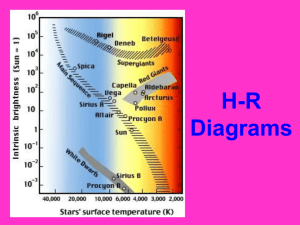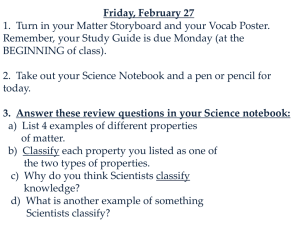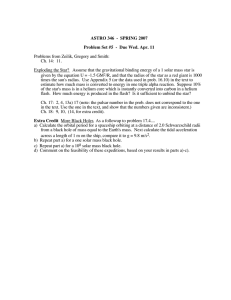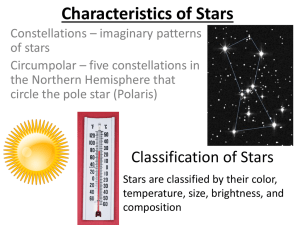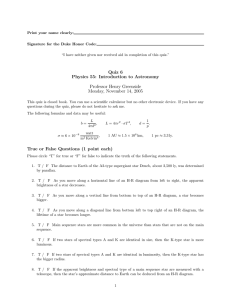Homework Assignment 9 Physics 55 Problem 1: Problems from the Text Made available:
advertisement
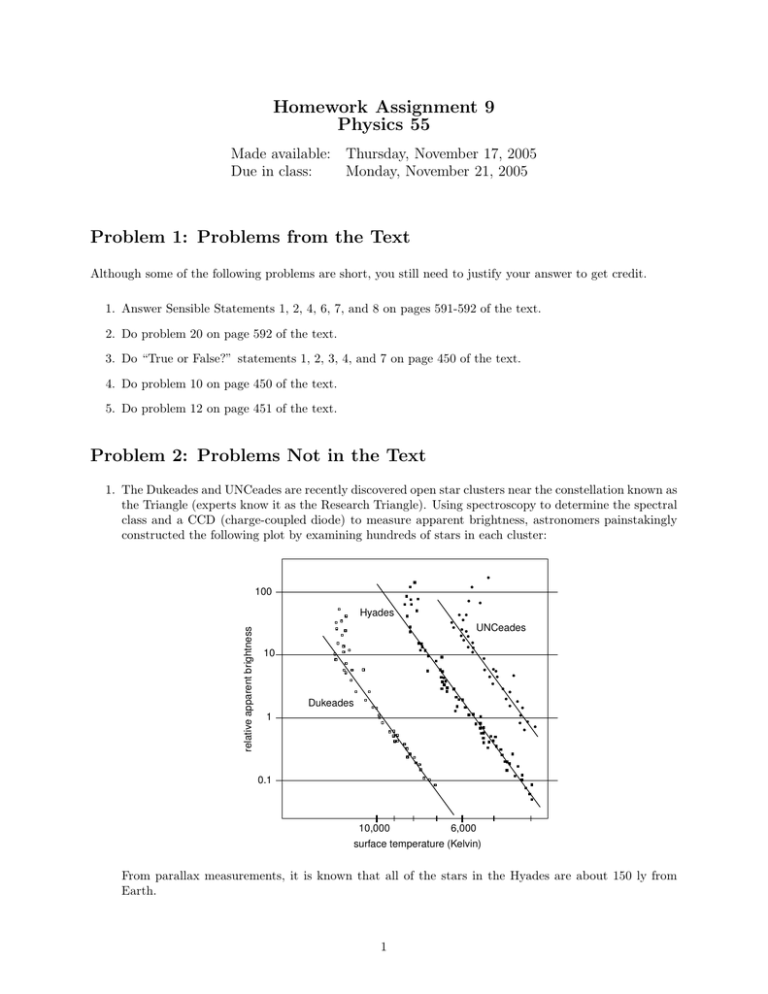
Homework Assignment 9 Physics 55 Made available: Due in class: Thursday, November 17, 2005 Monday, November 21, 2005 Problem 1: Problems from the Text Although some of the following problems are short, you still need to justify your answer to get credit. 1. Answer Sensible Statements 1, 2, 4, 6, 7, and 8 on pages 591-592 of the text. 2. Do problem 20 on page 592 of the text. 3. Do “True or False?” statements 1, 2, 3, 4, and 7 on page 450 of the text. 4. Do problem 10 on page 450 of the text. 5. Do problem 12 on page 451 of the text. Problem 2: Problems Not in the Text 1. The Dukeades and UNCeades are recently discovered open star clusters near the constellation known as the Triangle (experts know it as the Research Triangle). Using spectroscopy to determine the spectral class and a CCD (charge-coupled diode) to measure apparent brightness, astronomers painstakingly constructed the following plot by examining hundreds of stars in each cluster: 100 relative apparent brightness Hyades UNCeades 10 1 Dukeades 0.1 10,000 6,000 surface temperature (Kelvin) From parallax measurements, it is known that all of the stars in the Hyades are about 150 ly from Earth. 1 (a) Calculate the approximate distance in light years of the Dukeades cluster to Earth. (b) Calculate the approximate distance in light years of the UNCeades cluster to Earth. (c) Explain which cluster is oldest and which cluster is youngest. (d) Explain briefly why main-sequence fitting is a better way to estimate astronomical distances than choosing a single star of known spectral type and of known apparent brightness and then deducing the star’s distance from an H-R diagram, 2. Explain in one sentence why the periods of X-ray bursting pulsars speed up over time, while the periods of ordinary radio pulsars slow down over time. 3. To what mass density must the matter of a spherical dead star with mass 8 MSun be compressed for the star to disappear inside its event horizon? Is this density larger or smaller than the density 3 × 1018 kg/m3 at the center of a neutron star? Problem 3: Extra Credit In the off chance that some of you might like to think about these extra credit problems over the Thanksgiving holiday, you can hand in answers to these extra credit problems in class on Monday, November 28. However, the non-extra credit problems are still due on November 21. 1. Problem 24 on page 592 of the text: “Black Holes in Popular Culture”. 2. Suppose that the red supergiant star Betelgeuse, 430 ly away from Earth, becomes a supernova. Using Figure 18.5 on page 579 of the text, estimate how bright the supernova would be compared to the planet Venus and to the Moon, given that at maximum brightness Venus and the Moon have apparent magnitudes of respectively -4.4 and -12.5. 3. When trying to obtain an accurate measurement of a pulsar period, astronomers must take into account the Earth’s orbital motion about the Sun. (a) Explain qualitatively and conceptually why this is the case. (b) Estimate the maximum percent correction that would be needed for any pulsar period that would arises from the Earth’s orbital motion. (c) Explain why the largest correction arises for pulsars located near the ecliptic of the celestial sphere. 4. Show that the mass density ρ of matter needed to produce a black hole is inversely proportional to the square of the hole’s mass M . From your analysis, deduce what initial mass would be needed to produce a black hole such that the matter forming the black hole has the same density as water, 1000 kg/m 3, just as the black hole forms. Problem 4: Comments about the Homework and Course • About how long did it take you to complete this assignment? • Do you feel that you are understanding the course material? If not, please indicate what topics or ideas you would like to understand better. 2 • Comments or suggestions about other parts of the course such as reading, homeworks, lectures, or observation sessions? A bit of astronomical humor to get in the Thanksgiving holiday spirit: During a hiking trip, Sherlock Holmes and Dr. Watson pitch their tent under the stars and go to sleep. Sometime in the middle of the night, Holmes wakes Watson up and says excitedly, “Watson, look up at the sky, and tell me what you deduce.” After some deliberation, Watson says, “I see millions of stars, and if there are millions of stars, and if even a few of those have planets, it is quite likely there are some planets like Earth, and if there are a few planets like Earth out there, there might also be life.” Holmes replies, “Watson, you idiot, somebody has stolen our tent!” 3


